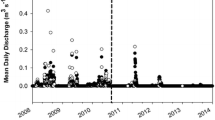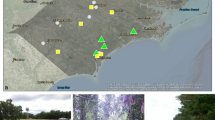Abstract
Stream and wetland-landscape patterns in watersheds that drain active-cranberry bogs, abandoned-cranberry bogs, and forest land with no history of cranberry agriculture were compared at three different levels of detail. Stream-pattern variables included drainage density, sinuosity, and the number, density, and length of ditches. Landscape-pattern measures included wetland-patch structure (the size, shape, and number of wetland patches) and cover-type composition. The results of the stream-pattern analysis indicated that the effect of past and present cranberry agriculture on stream-drainage patterns was limited primarily to the occurrence of ditches. A greater number, density, median length, and total length of ditches were observed in cranberry and abandoned-bog basins compared to forest basins. Drainage density and sinuosity of the remaining non-ditched stream segments did not differ between basin types. Excluding areas of active-cranberry bogs where the native vegetation was removed, there was no significant difference in the relative number, size, shape, and composition of the remaining vegetation-cover types between the three basin types. The exact type and extent of vegetation removed to establish bogs in the active and abandoned basins are not known, but based on soil type and vegetation class associations, it was estimated that the largest losses were of pitch pine lowlands and cedar swamps.



Similar content being viewed by others
References
Allan JD (1995) Stream ecology: structure and function of running waters. Chapman and Hall, London, England
Anderson JR, Hardy EE, Roach JT, Witmer RE (1976) A land use and land cover classification system for use with remote sensor data. U.S. Geological Survey Professional Paper 964, Washington, D.C., USA
Averill AL, Sylvia MM, Kusek CC, DeMoranville CJ (1997) Flooding in cranberry to minimize insecticides and fungicide inputs. Am J Altern Agric 12:50–54
Begon MJ, Harper L, Townsend CR (1996) Ecology: individuals, populations, and communities, 3rd edn. Blackwell Science, Cambridge, Massachusetts, USA
Collins BR, Russel EWB (1988) Protecting the New Jersey Pinelands. Rutgers University Press, New Brunswick, New Jersey, USA
Carlston, CW (1963) Drainage density and streamflow. USGS Professional Paper 422-C, Washington, DC, USA
Cook GH (1868) Geology of New Jersey. New Jersey Geological Survey, Newark, New Jersey, USA
Corry RC (2004) Characterizing fine-scale patterns of alternative agricultural landscapes with landscape pattern indices. Landsc Ecol 20:591–608
Cowardin LM, Carter V, Golet FC, LaRoe ET (1979) Classification of wetlands and deepwater habitats of the United States. U.S. Fish and Wildlife Service, FWS/OBS-79-31, Washington, DC, USA
Davenport JR (1996) The effect of nitrogen fertilizer rates and timing on cranberry yield and fruit quality. J Am Soc Hortic Sci 121:1089–1094
Eastwood B (1856) Complete manual for the cultivation of the cranberry with a description of the best varieties. Orange Judd and Company, New York, USA
Eck PE (1990) The American cranberry. Rutgers University Press, New Brunswick, New Jersey, USA
Epstein CM (2002) Application of Rosgen analysis to the New Jersey Pine Barrens. J Am Water Resour Assoc 38:69–78
Good RE, Good NF (1984) The Pinelands National Reserve: an ecosystem approach to management. Bioscience 34:169–173
Gordon ND, McMahon TA, Finlayson BL (1992) Stream hydrology: an introduction for ecologists. John Wiley and Sons, Chichester, England
Helsel DR, Hirsh RM (1992) Statistical methods in water resources. Elsevier Science, Amsterdam, Netherlands
Markley ML (1998) Soil series of the Pine Barrens. In: Forman RTT (ed) Pine Barrens: ecosystem and landscape. Rutgers University Press, New Brunswick, New Jersey, USA
McCune B, Grace JB (2002) Analysis of ecological communities. MjM Software Design, Gleneden Beach, Oregon, USA
McCune B, Mefford MJ (1999) Multivariate analysis of ecological data. MjM Software Design, Gleneden Beach, Oregon, USA
McGarigal K, Marks BJ (1994) Fragstats: spatial pattern analysis program for quantifying landscape structure, Version 2.0. Reference manual. Forestry Science Department, Oregon State University, Corvallis, Oregon, USA
Medley KE, Okey BW, Barrett GW, Lucas MF, Renwick WH (1995) Landscape change with agricultural intensification in a rural watershed, southwestern Ohio, U.S.A. Landsc Ecol 10:161–176
Mladenoff DJ, White MA, Pastor J (1993) Comparing spatial patterns in unaltered old-growth and disturbed forest landscapes. Ecol Appl 3:294–306
New Jersey Department of Environmental Protection (1996) New Jersey Geographic Information System CD-ROM, series 1, volumes 1–4
New Jersey Department of Environmental Protection (2001a) 1995/97 Land use/Land cover Update, Mullica Watershed Management Area, WMA-14. NJ Department of Environmental Protection, Office of Information Resources Management, Bureau of Geographic Information and Analysis, Trenton, New Jersey, USA
New Jersey Department of Environmental Protection (2001b) 1995/97 Land use/Land cover Update, Rancocas Watershed Management Area, WMA-19. NJ Department of Environmental Protection, Office of Information Resources Management, Bureau of Geographic Information and Analysis, Trenton, New Jersey, USA
New Jersey Agricultural Statistics Service (2007) New Jersey 2006 Cranberry Highlights. United States Department of Agriculture. Available from (http://www.nass.usda.gov/Statistics_by_State/New_Jersey/Publications/Cranberry_Statistics/cran2006.pdf (accessed June 2007)
O’Neill RV, Krummel JR, Gardner RH, Sugihara G, Jackson B, DeAngelis DL, Milne BT, Turner MG, Zygmunt B, Christensen SW, Dale VH, Graham RL (1988) Indices of landscape pattern. Landsc Ecol 1:153–162
Rice WR (1989) Analyzing tables of statistical tests. Evolution 43:223–225
Rice WR (1990) A consensus combined p-value test and the family wide significance of components tests. Biometrics 46:303–308
Roper BB, Kershner JL, Archer E, Henderson R, Bouwes N (2002) An evaluation of physical stream habitat attributes used to monitor streams. J Am Water Res Assoc 38:1637–1646
Shankman D (1996) Stream channelization and changing vegetation patterns in the U.S. Coastal Plain. Geogr Rev 86:216–232
Stang EJ (1996) The emerging cranberry industry in Chile. In: Yarborough DE, Smagula JM (eds) Sixth international symposium on vaccinium culture. Orono, Maine, USA, pp 159–163
Strahler AN (1957) A quantitative analysis of watershed geomorphology. Transactions of the American Geophysical Union 38:913–920
Tiner RW (2002) In search of swampland. Rutgers University Press, New Brunswick, New Jersey, USA
Turner MG, Ruscher CL (1988) Changes in landscape patterns in Georgia, USA. Landsc Ecol 1:241–251
Turner MG, Gardner RH, O’Neill RV (2001) Landscape ecology in theory and practice: pattern and process. Springer, New York, USA
United States Department of Agriculture, National Resource Conservation Service (2004) County Soil Surveys of New Jersey Digital Geographic Data. Distributed by New Jersey Department of Environmental Protection. Available at http://www.nj.gov/dep/gis (accessed March 2006)
White JJ (1885) Cranberry culture. Orange Judd and Company, New York, USA
Zampella RA, Bunnell JF (1998) Use of reference-site fish assemblages to assess aquatic degradation in Pinelands streams. Ecol Appl 8:645–658
Zampella RA, Bunnell JF (2000) The distribution of anurans in two river systems of a coastal plain watershed. J Herpetol 34:210–221
Zampella RA, Laidig KJ (1997) Effect of watershed disturbance on pinelands stream vegetation. J Torrey Bot Soc 124:52–66
Zampella RA, Moore G, Good RE (1992) Gradient analysis of pitch pine (Pinus rigida Mill.) lowland communities in the New Jersey Pinelands. Bull Torrey Bot Club 119:253–261
Zampella RA, Procopio NA, Lathrop RG, Dow CL (2007) Relationship of land-use/land-cover patterns and surface-water quality in the Mullica River Basin. J Am Water Res Assoc 43:594–604
Zar JH (1999) Biostatistical analysis, 4th edn. Prentice Hall Inc., Upper Saddle River, New Jersey, USA
Acknowledgements
We greatly thank Robert A. Zampella and Kim J. Laidig for their many suggestions on study design and their review of the final manuscript. We also thank Jason Shvanda, Christina Burns, Jennifer Ciraolo, and Russell Davis for assisting with various aspects of this study. Funding for this study was provided by the U.S. Environmental Protection Agency (State Wetlands Grant Program, Grant No. CD-99298001-1) and the New Jersey Pinelands Commission. This paper is based in part on a report submitted to the U.S. Environmental Protection Agency and a doctoral dissertation submitted to Drexel University.
Author information
Authors and Affiliations
Corresponding author
Rights and permissions
About this article
Cite this article
Procopio, N.A., Bunnell, J.F. Stream and wetland landscape patterns in watersheds with different cranberry agriculture histories, southern New Jersey, USA. Landscape Ecol 23, 771–786 (2008). https://doi.org/10.1007/s10980-008-9235-6
Received:
Accepted:
Published:
Issue Date:
DOI: https://doi.org/10.1007/s10980-008-9235-6




